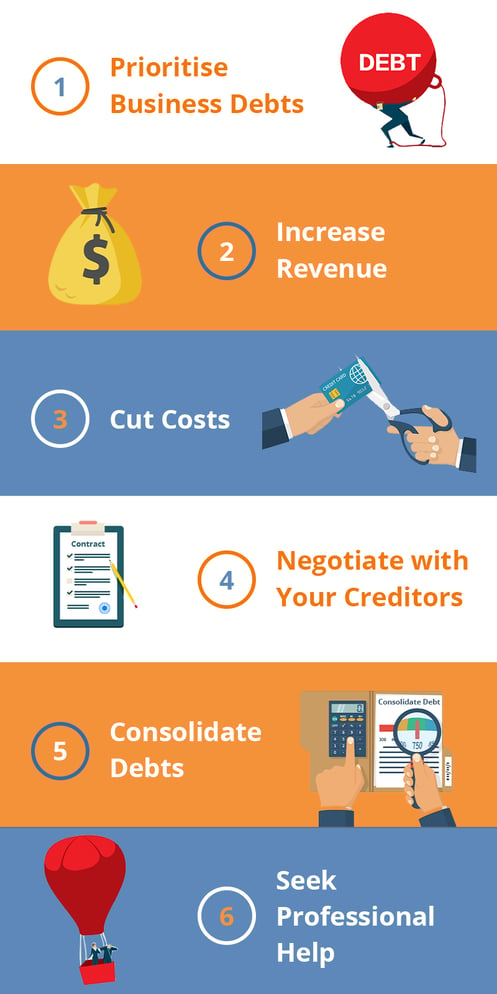For many business owners, taking on business debt is a good thing. It can help you grow your business, finance further business opportunities, purchase more items and expand your offerings. However, sometimes business debt can get out of control, especially if your business is having difficulty meeting sales projections.
If your business is struggling with outstanding debts, there are ways for you to regain financial control without going into Voluntary Administration or Company Liquidation. Follow the below 6 steps to get out of business debt and save your business from insolvency.

1. Prioritise Business Debts
The first step to paying off your business debt is to prioritise. Prioritising your debts can help get creditors off your back. Take inventory of all your debts by creating a business budget. Your budget should include:
- Which debts are critical and need to be paid off quickly,
- Debts that may affect your business relationships, and
- Debts with high interest rates and penalties attached for non-payment.
Unfortunately, there isn’t one way to prioritise your debt and each business is different. You need to take time to understand your business’ financial situation and debts in order to prioritise them and determine what to pay off first.
2. Increase Revenue
Once you have made a budget and decided which debts you need to pay down first, you can think about ways to boost your revenue and increase sales. Some examples include:
- Create promotions to generate interest from your customers.
- Introduce a new loyalty program for loyal customers such as discounts or monthly coupons.
- Get active on social media and engage with your customers. In doing so, you encourage conversation around your products/services and increase brand recognition. This also gives you the opportunity to offer competitions, prizes and gives your customers the ability to leave positive reviews of your brand.
- Raise prices. With the right strategy, such as offering a discount when customers buy in bulk, you can raise your prices without losing customers. This can help give your business a competitive edge.
3. Cut Costs
By increasing revenue and boosting sales, you should have enough money to tackle your business debts. However, if business expenses are still running too high, you may be able to cut costs to reduce your spending. You can start by taking another look at your budget. If you’re aware of where your money is going, the opportunities to cut costs should become apparent. Some opportunities may be to:
- Lower office space costs. You may be able to relocate your business to a more affordable location or negotiate with your current landlord for better terms.
- Buy equipment second hand or on lease. Although there is nothing better than buying new equipment, second hand equipment often gets the job done at a fraction of the cost.
- Use freelancers. Freelancers fill holes in your workforce when you don’t want to commit to a long-term employee. This allows your business to save money. Unlike employees, once the job is complete, the freelancer doesn’t work for you anymore.
4. Negotiate with Your Creditors
Communication with creditors is key if your business is in debt. Creditors don’t want your business to fail because if your business goes into Company Liquidation, they don’t get anything. If you’ve consistently paid bills on time and kept a positive relationship with creditors in the past, they are more likely to be cooperative in times of financial crisis. Creditors may help you by reducing interest rates, allowing you to make smaller minimum repayments or extend a payment plan term.
5. Consolidate Debts
Debt consolidation allows you to consolidate your unsecured business debts, such as personal loans and business credit cards, into a single loan. The goal of debt consolidation is to obtain a lower interest rate and set of fees to help pay off your debt faster. When looking for a debt consolidation loan, be aware of the interest rate, length of the payment term and the minimum monthly repayment.
6. Seek Professional Help
If you’ve tried all of the above steps and your business is still experiencing financial difficulties, it’s time to seek professional help. It’s in your best interest to act quickly to give your business its best chance of survival and avoid a formal insolvency appointment. Our partner, Revive Financial, can help implement a turnaround strategy (such as a business restructure) to get your business back on track. A successful business turnaround will allow you to continue to trade with greater stability by:
- Helping to address disturbances in the business’ cash flow,
- Decreasing staff turnover due to resignation,
- Develop operational efficiencies to improve earnings, and
- Speed up a troubled company’s return to profitability.
Further Business Debt Options
If your business is struggling financially and you believe it may not survive, there are formal business insolvency options available to help you avoid the risks of trading insolvent and personal liability.
Voluntary Administration
Voluntary Administration provides you with breathing space while an independent Voluntary Administrator takes control of the business to improve cash flow and prepare a Deed of Company Arrangement (DOCA). Voluntary Administration can help keep your business afloat.
Company Liquidation
You may need to consider Company Liquidation if all other options to save the business have been exhausted. Liquidating your company will give you closure and the ability to move on. The stress and anxiety of dealing with overwhelming business debt will start and ease and you’ll be able to get on with your life.
Revive Financial helps all businesses and individuals get out of debt, once and for all. If you’re struggling, get in touch with our experienced team today on 1800 861 247 for a free 30-minute consultation.
See how we can help with our Instant Online Assessment.

%20.gif)